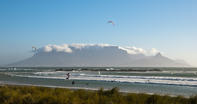Protective Buffer Zone

A better approach to coastal management, most global experts now agree, is one that involves solutions at a social and institutional level. Instead of throwing up a wall of concrete in the face of an encroaching tide, one way to respond is, where possible, to take a step back from it.
A setback line is a ‘soft’, precautionary approach which is robust and flexible. However it needs deliberate and careful implementation, as is currently underway in the City of Cape Town.
A setback line comes from global best practice, and is a demarcated line drawn along the coast, based on a range of factors, including risk from storm surges and sea level rise. It creates a protective ‘buffer zone’ in which development is either forbidden, or is strictly controlled, and allows for ecosystems to be restored and protected in that buffer zone, so they can offer additional defence against an aggressive sea.
Spatial planning tools can be used as regulatory mechanisms to support setbacks, which can’t work in isolation. Overlay zones are applied to areas inland and seaward of the setback line, designating specific development criteria and restrictions based on the varying risk profiles in each area. A measure like this must be clearly mapped out, decreed and enforced through policy and planning regulation.